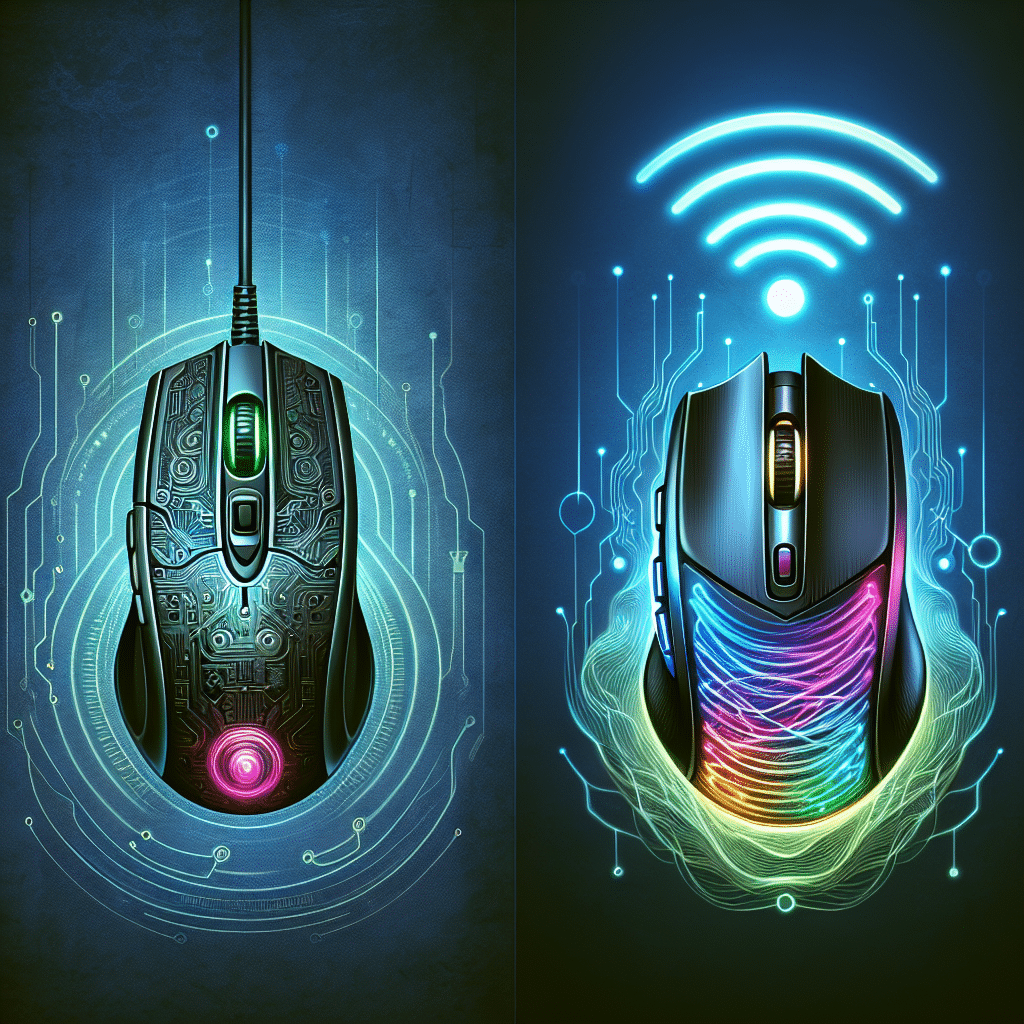Wired vs. Wireless Gaming Mice: A Comprehensive Guide
Understanding Mouse Technologies
Gaming mice come in two primary categories: wired and wireless. Both have their advantages and disadvantages, targeting different types of gamers and preferences. This guide will delve into their technologies, performance, and overall user experience.
Wired Gaming Mice
1. Connectivity
Wired gaming mice connect directly to the computer via USB. This direct connection offers an immediate response and eliminates potential input lag associated with wireless mice.
2. Reliability and Consistency
Wired mice provide a consistent connection without interference from other wireless devices. Gamers do not have to worry about battery levels, ensuring uninterrupted gameplay. The reliability of wired connections is a significant factor for competitive gamers requiring precision.
3. Performance
- Latency: Wired mice generally offer lower latency (often under 1 ms) compared to wireless counterparts, making them ideal for fast-paced gaming.
- Polling Rate: The polling rate, measured in Hz, indicates how often the mouse reports its position to the computer. Most wired mice provide polling rates up to 1000 Hz, delivering precise tracking.
4. Weight and Feel
Wired mice typically weigh more due to the internal battery and components present in their wireless counterparts. Some gamers prefer the heftiness of wired mice, providing a more grounded feel during intense gaming sessions.
5. Price Point
Wired gaming mice are generally more affordable than wireless models, as they often require fewer advanced technologies. This price advantage allows gamers on a budget to find high-quality options without sacrificing performance.
Wireless Gaming Mice
1. Advancements in Technology
Modern wireless gaming mice have improved significantly in the last few years. Technologies like Logitech’s Lightspeed and Razer’s HyperSpeed have bridged the performance gap between wired and wireless mice, enabling ultra-low latency and reliable connectivity.
2. Freedom of Movement
A primary benefit of wireless mice is the freedom they provide. Gamers can move their hands without being restricted by a cord, allowing for a more natural gaming posture and unhindered movements, which is crucial for extended gaming sessions.
3. Battery Life
Contemporary wireless mice come equipped with impressive battery lives, often lasting from 40 to 100 hours on a single charge. Many have features like low-battery indicators and sleep modes to extend usability. Additionally, some models support quick charging.
4. Lag and Interference
While early wireless mice struggled with lag and connection interruptions, technological advancements have significantly minimized these issues. Most high-end wireless mice boast performance comparable to wired counterparts, making them suitable for competitive gaming.
5. Customization and Features
Many wireless models come with customizable features, including programmable buttons, adjustable DPI settings, and RGB lighting. These options cater to diverse gaming styles, allowing players to tailor their setups to their specific needs.
Choosing the Right Mouse
1. Type of Game Played
-
FPS Games: Gamers who favor first-person shooters often prefer wired mice due to their low latency and consistent performance. Precise aim can make all the difference in competitive gameplay.
-
MMORPGs and MOBA Games: Players engaged in role-playing games and multiplayer online battle arenas might lean towards wireless peripherals for their convenience and customizable features, allowing for multiple hotkey settings during gameplay.
2. Personal Preference
Individual preferences differ significantly. Some gamers prefer the tactile feedback of a wired connection, while others may enjoy the freedom and ergonomics offered by wireless models.
3. Space and Setup
Consider your gaming setup. If your gaming area is cramped or involves multiple monitors, a wireless mouse eliminates the clutter of cables, allowing for a cleaner workstation. Conversely, if your desk allows for ample space, a wired connection may pose no inconvenience.
4. Budget Considerations
While wired mice generally have a lower price tag, some high-quality, budget-friendly wireless options are available. Weigh your priorities against your budget to determine which category suits your needs.
Key Specifications to Consider
1. DPI (Dots Per Inch)
Higher DPI settings enhance sensitivity, making movements appear faster on the screen. A higher DPI is crucial for competitive gaming, particularly in fast-paced FPS games. Most wired and wireless gaming mice offer adjustable DPI settings suitable for various gameplay styles.
2. Ergonomics
An ergonomic design is vital for comfort during prolonged gaming sessions. Each mouse features different grip styles—palm, claw, and fingertip grips—with unique ergonomic considerations that might attract certain gamers.
3. Sensor Quality
Optical sensors typically provide better tracking and responsiveness than laser sensors in gaming mice. The sensor type is crucial, as this affects real-time tracking efficiency and overall performance.
4. Weight Adjustment
Some high-end gaming mice allow players to adjust the weight using interchangeable weights. Adjusting the weight can help create a balanced feel that enhances control and comfort.
Maintenance and Care
1. Cable Management for Wired Mice
Wired mice require cable management to prevent tangling. Consider investing in a mouse bungee or cable guides to keep the wire off your desk.
2. Cleaning
Both wired and wireless mice accumulate dust and grime. Regular cleaning is essential, especially around sensor areas. Use a soft cloth and compressed air to keep your device in optimal condition.
Final Insights
When choosing between wired and wireless gaming mice, consider factors such as personal preference, gaming style, and budget. Evaluation of performance, comfort, and ergonomics will guide the decision-making process. With advancements in technology, the gap between the two categories narrows, opening more possibilities for gamers to find their ideal fit.
